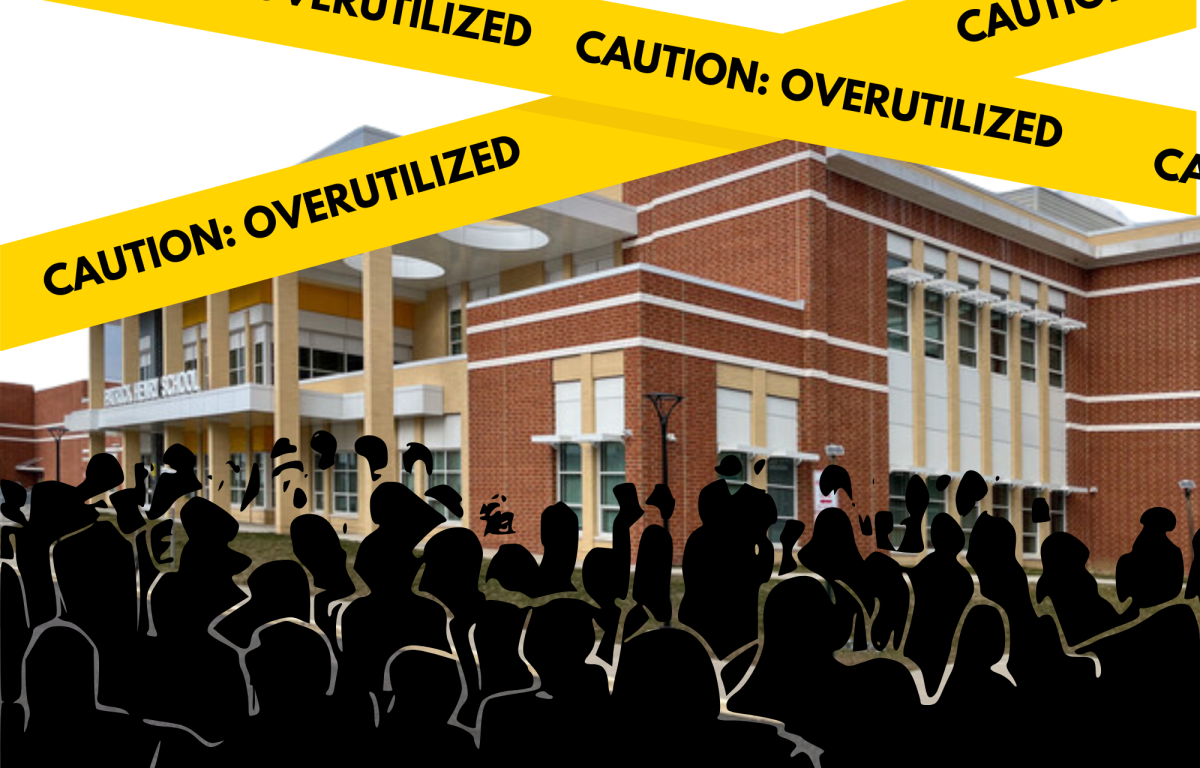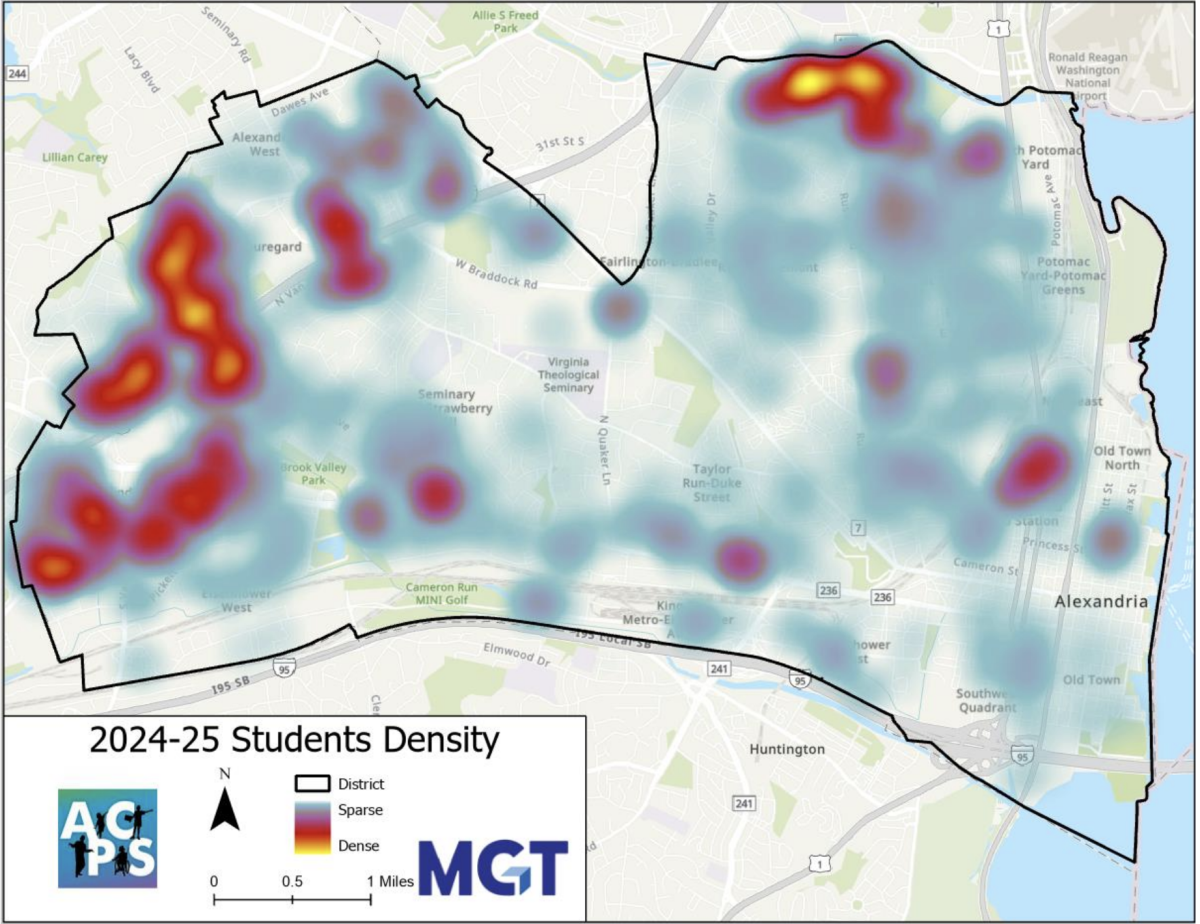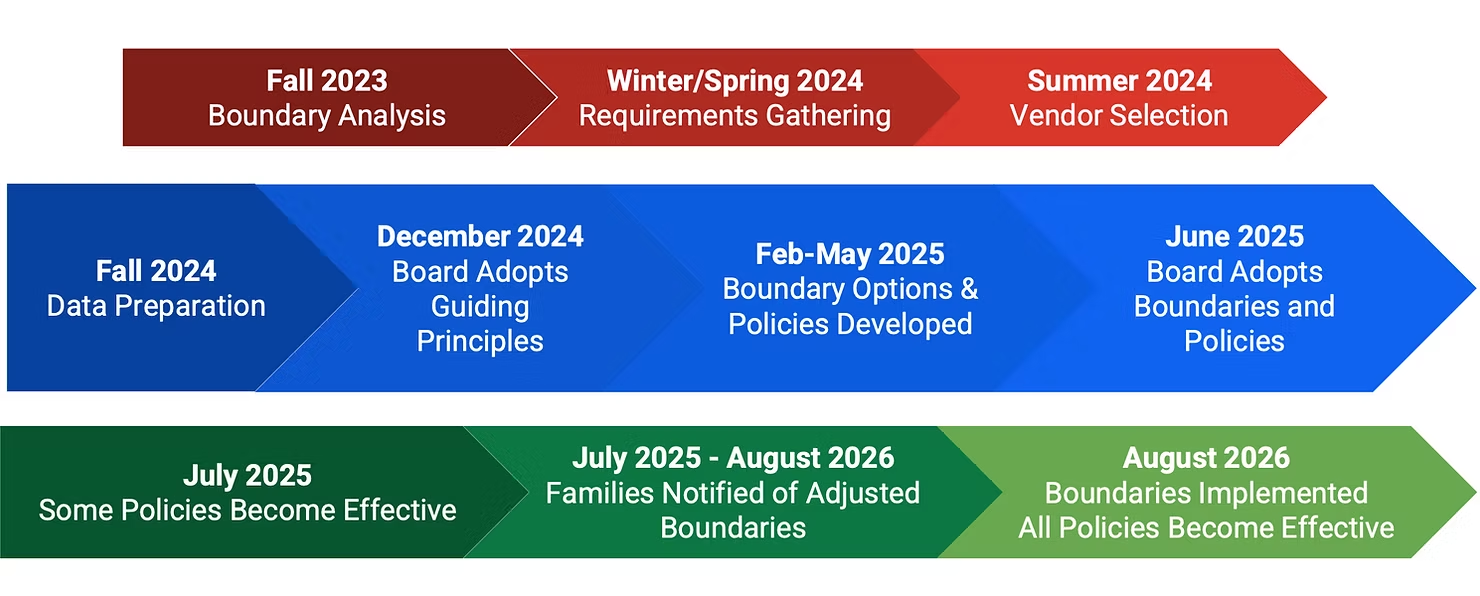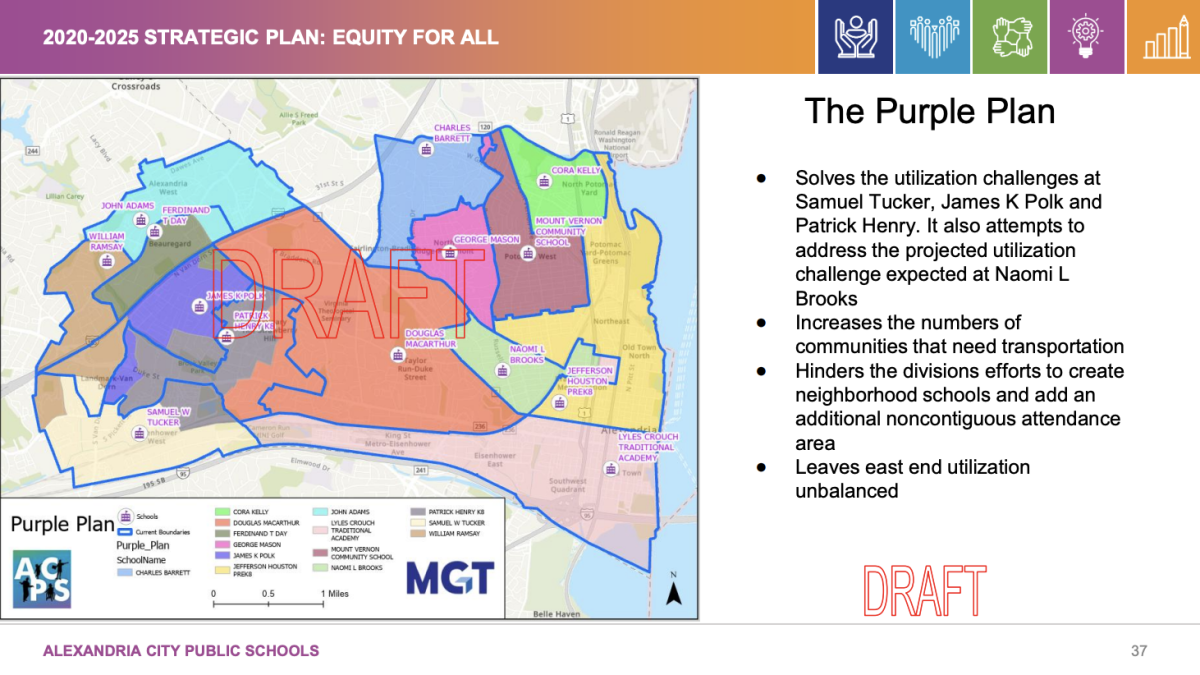
Isabel Shultz
Patrick Henry is the most crowded school in Alexandria.
Sofia, an elementary student at the Patrick Henry school, walks into her classroom each morning with a smile on her face, excited to learn. But Sofia’s school, along with the schools of thousands of other students in Alexandria, is bursting at the seams. At 152% capacity, Patrick Henry — which serves grades K-8 — is the most overutilized school in the city.
“It feels really welcoming and very energetic when you walk into the doors, … but it feels very full,” Sofia, whose parents requested to withhold her last name for privacy reasons, said.
That experience isn’t unique. Across Alexandria’s school system, six elementary schools, two middle schools and the sole high school in the city are at or above their intended utilization rate*. Disproportionately impacted are schools on the West End: five out of the seven schools west of Quaker Lane are overcrowded, compared to three out of the nine east of Quaker Lane (excluding the high school).
And as the city continues to grow, the school district’s data projects that some of these schools will expand even further over capacity.
The Problem
Overcrowding is nothing new, and parents have expressed frustration at the lack of a solution for years, though those complaints became especially prominent in 2023. After a boundary analysis that year confirmed overcrowding concerns, Alexandria City Public Schools initiated the process of redistricting — but no changes have been made as of yet.
“[Our] most important goal is wanting to make sure that every child receives the support that they need in school,” said Michelle Rief, the chair of the school board, in an interview. “So the board decided [after the boundary analysis] that, yes, we do think redistricting is needed.”
Current districting
School
Capacity
2024 school year
2029 school year
2034 school year
Elementary Schools
Charles Barrett
512
109%
95%
92%
Cora Kelley
429
67%
68%
39%
Douglas MacArthur
840
79%
81%
78%
Ferdinand Day
640
106%
91%
88%
George Mason
368
77%
79%
42%
James Polk
756
100%
99%
103%
Jefferson-Houston (K-8)
516
71%
104%
66%
John Adams
858
76%
61%
60%
Lyles Crouch
375
106%
78%
75%
Mount Vernon
755
90%
99%
92%
Naomi Brooks
350
97%
120%
108%
Patrick Henry (K-8)
629
152%
184%
133%
Samuel Tucker
620
122%
118%
115%
William Ramsay
748
76%
79%
77%
Middle Schools
George Washington
1438
99%
—
—
Francis Hammond
1511
108%
—
—
High School
King St. and Minnie Howard campuses
4500
99%
—
—
Satellite campus
100
95%
—
—
Chance for Change campus
40
113%
—
—
Sources: ACPS, ALXnow
According to ACPS data presented to the school board, the highest “utilization rates” in elementary schools are at Patrick Henry and Samuel Tucker, which are 152% and 122% over capacity, respectively. Without redistricting, both schools are projected to remain overutilized going into 2029 and 2034. Even on the East End, schools like Naomi Brooks and Mount Vernon will face the same problems.
In the meantime, parents and students are feeling the impact.
“The school just doesn’t have enough resources for the kids or the parents,” said Jakob Wolf-Barnett, the parent of a third-grade student at Patrick Henry.
“It’s not for lack of trying,” he added. “It’s just that there are too many kids.”

Sofia said she has noticed that her teacher’s attention is often divided in class.
“Sometimes, [my teacher] is worried about other kids because there’s so many of them,” Sofia said. “When I need help on something, sometimes she has to focus on other kids that need more help than me,” she said.
Anne Koster, the parent of a fifth-grade and a kindergarten student at James Polk, echoed these issues for her children and said she wished the school district had a more efficient response.
“[I] believe that there should be a way to work out a solution that is inclusive, transparent and responsive to needs across the city on a much faster timeline,” Koster said.
Rief says she understands the frustration of parents, especially because the redistricting process has a strong effect on families.
“Redistricting is challenging because whenever you’re looking at adjusting school attendance zones, it does impact people and where their children go to school,” Rief said. “And so I think that always makes it a difficult decision to make. But I think that we are doing our best to really take in all the community input.”
Wolf-Barnett said that even though some of the plans proposed by ACPS may not be perfect, he is grateful for the work the school district is doing.
“I appreciate the fact they’ve taken this seriously,” he said. “Each of these plans is better than what we have right now. That’s a marked improvement that should be acknowledged.”
The Process
To ease the daunting task of redrawing boundary lines, ACPS split the work between two groups.
The Redistricting Steering Committee — which is made up of ACPS Central Office staff and private consultants — is at the helm of the effort, crafting and proposing boundary lines to the school board.
The Redistricting Advisory Committee, which is composed of separate ACPS staff and community members, shares information with and gathers feedback from stakeholders in their communities based on the proposed boundary lines and other plans, and in return shares that feedback with the Redistricting Steering Committee and the school board.
“Our role is communicating with the community and understanding the process, as opposed to being advocates for any particular plan,” said Hal Cardwell, an at-large representative on the Redistricting Advisory Committee who is also former school board member.
“At the same time, ACPS is asking us our opinions of the plans and of the process, so there is some of that going on too, in terms of giving feedback,” he added.
Ultimately, it is up to the school board to vote on redistricting. Rief said that she and ACPS have designed a number of vehicles for community members to share feedback.
“We intentionally try to create a lot of different ways so that people can find what works for them,” she said. “There’s public comment at meetings. You can email the school board. You can email ‘Ask ACPS.’ … You can also engage with somebody who’s serving on the Redistricting Advisory Committee.”
ACPS also scheduled a redistricting community meeting for April 22, both online and in-person at the King St. campus of Alexandria City High School. For planning purposes, Rief said the school district is requesting that attendees sign up in advance.
“That’s a great opportunity to come and have some interaction,” Rief said.
In addition, ACPS has scheduled two public hearings for later this school year — one on May 12 and another on June 5.
But even after potential school board approval of redistricting plans, the City Council must vote to appropriate additional funds if they are requested by the school board. Notably, the City Council recently declined to provide ACPS with funds to convert Jefferson-Houston — which currently holds grades K-8 — into a middle school. ACPS currently faces a lawsuit aiming to block the conversion.
Julia Burgos, chief of school and community relations for ACPS, told Theogony that the school district could not comment on potential City Council appropriation votes due to the ongoing lawsuit.

It was around the time of the December, 2024 vote to convert Jefferson Houston that the school board began to consider guiding principles for redistricting.
The Plans
In early March, the Redistricting Steering Committee released three potential plans for redistricting, labeled the Purple, Blue and Green plans. All three focused primarily on easing overutilization on the West End.
A similar feature of all three maps was the expansion of Douglas MacArthur’s boundary further west into Patrick Henry’s current boundary. Additionally, all three expanded James Polk’s boundary down into the southwestern portion of Patrick Henry’s boundary, while simultaneously expanding Patrick Henry’s boundary to the north and south.

Following that meeting, parents requested more clarity surrounding the maps, which didn’t include specific street names — a feature that Wolf-Barnett and Koster said was necessary to fully support public understanding.
According to Rief, the school district will soon release a “tool … where people can put in their address and see how they might be impacted.”
In late March, two additional plans — Orange and Yellow — were released to the public. These plans focused more on reworking East Side boundaries. Additionally, the Blue, Green and Purple plans were re-released in greater detail.
The main East Side changes offered by the Orange and Yellow maps were the expansion of the George Mason boundary north into the Charles Barrett boundary and west into the Douglas MacArthur boundary. A small exclave of the George Mason boundary, located at the edge of Alexandria’s northern border, was also redistricted to be part of Charles Barrett’s boundary.
Rief and Cardwell said they expect several more plans to be proposed before the school board makes its final decision.
“It is unlikely that any of these plans will be the one that is recommended to the board and or voted on by the board,” said Cardwell. “It’s an iterative process. These were the first iterations that we had seen.”
The process may be ongoing, but Sofia said she will continue to keep her spirits up.
“Patrick Henry is crowded, definitely,” she said. “[But] it’s really fun to be there.”
*George Washington Middle School and Alexandria City High School are both at 99% capacity. Our analysis considered both schools as being fully utilized.
This article is part one in a series examining ACPS’s redistricting process.